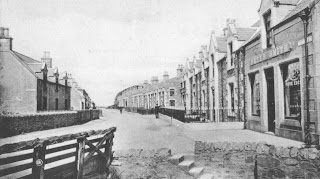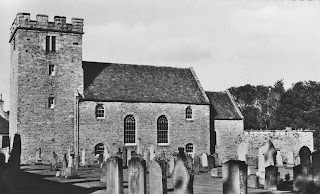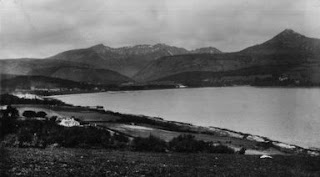Sir James Matthew Barrie, 1860-1937). Dramatist and novelist. He was born on the 9th of ay 1860 in Kirriemuir, Scotland, the ninth child of a weaver. When Barrie was seven, David, his older brother and his mother's favourite son, was killed in a skating accident; from that date Barrie strove to fill the vacant place in his
mother's affections and he became exceptionally close to her. In later life he told the story of that relationship in a sentimental biography, Margaret Ogiivy (1896). Between 1867 and 1871 he was educated at the Glasgow Academy where his oldest brother, Alexander, was a master, and subsequently at Forfar Academy and Dumfries Academy from 1873 to 1878, when he matriculated at the University of Edinburgh. There he studied English in the class of Professor David Masson and he became a regular reviewer of theatre for the Edinburgh Courant and of books for The Scotsman. In 1882 he was appointed a leader-writer on the Nottingham Journal and he held the post until 1884 when he returned home to Kirriemuir. From there he began contributing to Sir Frederick Greenwood's St James's Gazette and Cornhill Magazine the stories of Scottish village life, its characters and religious principles, told to him by hismother. These were later published in Auld Light Idylls (1888) and they present a humorous, but sentimental, caricature of rural manners in Thrums, the village that disguised the reality of Kirriemuir. Their cloying picture of rural life belongs properly to the kailyard school of writing. A second collection, A Window in Thrums, was published in 1889.
In 1885 Barrie moved to London to work as a journalist and he started writing, under the pseudonym Gavin Ogilvy, for the British Weekly, which was edited by William Robertson Nicoll. Barrie's growing success was consolidated by his second novel When a Man's Single (1888) (Better Dead, his first novel, had been published at his own expense in 1886 and it was reissued in 1888), An Edinburgh Eleven: Pen Portraits of College Life (1889), his reminiscences of university life in Edinburgh, and his most successful novel The Little Minister (1891), which he dramatized for the stage in 1897. Barrie married the actress Mary Ansellon 9 July 1894 but their marriage seems never to have been consummated and it broke up in 1909 when Mary left him for Gilbert Canaan, a barrister and secretary to Barrie's Censorship Committee. Something of the futility of Barrie's marriage can be seen in two novels, Sentimental Tommy (1896) and its sequel Tommy and Grizel (1900). Barrie visited America in 1896 and on his return he met the Llewellyn Davies family with whom, especially the children, George, Jack, Peter, Michael and Nicholas, he was to enjoy a close relationship.
For the boys he wrote The Little White Bird (1902), a fantasy set in Kensington Gardens, and out of that book and out of their close relationship he wrote his best-known work, Peter Pan, or The Boy who Wouldn't Grow Up (1904): "I suppose I always knew that I made Peter Pan by rubbing the five of you violently together, as savages with two sticks produce a flame. I am sometimes asked who and what Peter is, but that is all he is, the spark I got from you." (Unpublished draft of the dedication to a performance of Peter Pan in 1926.) The play was Barrie's greatest success and has remained popular with children ever since, with its make-believe world of fairies, pirates and Red Indians in the Never-Never Land inhabited by Peter Pan. It also contains elements of Barrie's own obsession with mother love and with the lost world of childhood. The story of the play was published in book form in Peter and Wendy in 1911. Barrie's first successful play was The Little Minister (1897), and from the beginning of his theatrical career he demonstrated a command of language and grasp of stagecraft, allied to an ability to create rounded, realistic characters. His principal plays were as follows (here and throughout this paragraph dates given are those of first performance); Quality Street (1901), a love story set in the Napoleonic Wars; The Admirable Crichton (1902), a comedy about the effects of a butler becoming a dictator when a family is shipwrecked; What Every Woman Knows (1908), which suggests that behind every successful man is a stalwart, charming wife like Maggie, who in the memorable first act questions her position as an appendage to her husband; A Kiss for Cinderella (1916), an attempt to revive the fantasy of Peter Pan; Dear Brutus (1917) which with its famous, sentimental scene in Lob's wood explores the theme that people can be given a second chance in life; Mary Rose (1920), a whimsical story about a dead mother's love for her son; Shall We Join the Ladies ? (1921) an uncompleted murder mystery; and his last play, an unsuccessful religious drama, The Boy David (1936).
After the deaths of Arthur Llewelyn Davies in 1907 and his wife in 1910, Barrie's relationship with their sons grew even closer and he became their guardian and unofficial step-father. He also befriended the family of Captain Robert Scott (1868 -1912), the Polar explorer. Barrie's adoration of attractive women and their children was to remain an obsession throughout his life; he also enjoyed the friendship of many of the leading political and literary men of his time. His services to literature were rewarded with a baronetcy in 1913 (he had turned down a knighthood in 1909), and other public honours, including the Order of Merit in 1922, the year that, as Rector of the University of St Andrews, he gave his rectorial address on 'Courage'; he was also Chancellor of the University of Edinburgh. He died on 19 June 1937.
Barrie was one of the most successful and popular dramatists of his day but none of his plays has withstood the test of time. In some works such as The Admirable Crichton and What Every Woman Knows, he questioned social mores, but in weak endings he allowed the status quo Co prevail (Crichton returns to his position as a butler, Maggie takes up her wifely duties), although in the latter play his portrait of a Scotsman 'on the make' is perfectly drawn. As his career progressed he became increasingly involved in the worlds of fantasy and faery and in the search for the lost world of childhood, and he is still best remembered for the creation of Peter Pan. In his early Scottish stories sentimentality and bathos are occasionally kept at bay by his pawky humour and social observation, but at the heart the Auld Licht stories, set in Thrums, are artificial and devoid of life. His other novels and works of non-fiction are: My Lady Nicotine (1890), a novel extolling the joys of smoking; Courage (1922), the text of his St Andrews rectorial address; The Greenwood Hat (1930), a privately printed collection of autobiographical sketches; and Farewell Miss Julie Logan (1932), a love story set in Scotland.
Works: Better Dead (1886); Auld Licht Idylls (1888); When a Man's Single (1888);
An Edinburgh Eleven: Pen Portraits of College Life (1889); A Window in Thrums 1889); My Lady Nicotine (1890); The Little Minister (1891); Richard Savage (1891); A Holiday in Bed (1892); Allahakbarries (1893); An Auld Licht Manse (1893); with Arthur Conan Doyle, Jane Annie (1893); A Lady's Shoe (1893); A Tillyloss Scandal (1893); Two of Them (1893); The Sabbath Day (1895); Scotland's Lament (1895);
Margaret Ogiivy (1896); Sentimental Tommy (1896); The Allahakbarrie Book of Broadway Cricket for 1899 (1899); Life in a Country Manse (1899); Tommy and Grizel (1900);
The Wedding Guest (1900); The Little White Bird (1902); Peter Pan in Kensington Gardens (1906); Walker, London (1907); George Meredith (1909); Peter and Wendy (1911); Quality Street (1913); The Admirable Crichton (1914); Oer Tag (1914); Half Hours (1914) Pantaloon (1914) Rosalind (1914); The Twelve-Pound Look (1914); The Will (1914); Charles Frohman (1915); Shakespeare's Legacy (1917); Who was Sarah Findlay ? by Mark Twain. With a Suggested Solution of the Mystery (1917); Echoes of the War (1918); The New Word (1918); The Old Lady Shows Her Medals (1918); A Well Remembered Voice (1918); What Every Woman Knows (1918); A Kiss for Cinderella (1920); Courage (1922); Dear Brutus (1923); Mary Rose (1924); Neil and Tintinnabulum (1925); Shall We Join the Ladies? (1927); TheGreenwood Hat (WO); Farewell Miss Julie Logon (1932).
Tour Kirriemuir, Scotland, on an
Ancestry Tour of Scotland.
Best Scottish Tours,
Best Scottish Food,
Best Scottish Hotels,
Small Group Tours of Scotland.
Rent a Cottage in Scotland.
Golf Scotland.
Tour Scotland.
Tour Roman Scotland.
Ancestry Scotland Research,
Birdwatching Scotland,
Guidebooks Scotland,
Edinburgh Travel Guides,
Coast Scotland,
Scotland Maps,
Self Catering Scotland, Tour Scotland.


















